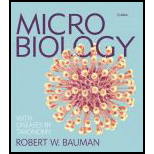
Concept explainers
a.
To determine:
The differences in the diffusion rates of chemicals A and B.
Introduction:
The membrane that is present below the cell wall and glycocalyx is a cytoplasmic membrane. It is also known as plasma membrane or cell membrane. The structure of the cytoplasmic membrane is referred to the phospholipid bilayer and the membrane of bacteria is composed of integral proteins. Peripheral proteins are loosely attached to the membrane on one or another side which acts as enzymes, receptors, recognition proteins, and carriers.
Cell membrane controls the movement of substances inside and outside of the cell with the main function of protecting the cell for the surroundings. It also provides shape to the cell and involves in different cellular processes such as cell signaling, cell adhesion, and ion conductivity.
b.
To explain:
The reason that diffusion rate of chemical A taper off.
Introduction:
The membrane that is present below the cell wall and glycocalyx is a cytoplasmic membrane. It is also known as plasma membrane or cell membrane. The structure of the cytoplasmic membrane is referred to the phospholipid bilayer and the membrane of bacteria is composed of integral proteins. Peripheral proteins are loosely attached to the membrane on one or another side which acts as enzymes, receptors, recognition proteins, and carriers.
Cell membrane controls the movement of substances inside and outside of the cell with the main function of protecting the cell for the surroundings. It also provides shape to the cell and involves in different cellular processes such as cell signaling, cell adhesion, and ion conductivity.
c.
To determine:
The way in which the cell increase the diffusion rate of chemical A.
Introduction:
The membrane that is present below the cell wall and glycocalyx is a cytoplasmic membrane. It is also known as plasma membrane or cell membrane. The structure of the cytoplasmic membrane is referred to the phospholipid bilayer and the membrane of bacteria is composed of integral proteins. Peripheral proteins are loosely attached to the membrane on one or another side which acts as enzymes, receptors, recognition proteins, and carriers.
Cell membrane controls the movement of substances inside and outside of the cell with the main function of protecting the cell for the surroundings. It also provides shape to the cell and involves in different cellular processes such as cell signaling, cell adhesion, and ion conductivity.
d.
To determine:
The way in which the cell increase the diffusion rate of chemical B.
Introduction:
The membrane that is present below the cell wall and glycocalyx is a cytoplasmic membrane. It is also known as plasma membrane or cell membrane. The structure of the cytoplasmic membrane is referred to the phospholipid bilayer and the membrane of bacteria is composed of integral proteins. Peripheral proteins are loosely attached to the membrane on one or another side which acts as enzymes, receptors, recognition proteins, and carriers.
Cell membrane controls the movement of substances inside and outside of the cell with the main function of protecting the cell for the surroundings. It also provides shape to the cell and involves in different cellular processes such as cell signaling, cell adhesion, and ion conductivity.
Want to see the full answer?
Check out a sample textbook solution
Chapter 3 Solutions
Microbiology with Diseases by Taxonomy (5th Edition)
- What is behavioral adaptarrow_forward22. Which of the following mutant proteins is expected to have a dominant negative effect when over- expressed in normal cells? a. mutant PI3-kinase that lacks the SH2 domain but retains the kinase function b. mutant Grb2 protein that cannot bind to RTK c. mutant RTK that lacks the extracellular domain d. mutant PDK that has the PH domain but lost the kinase function e. all of the abovearrow_forwardWhat is the label ?arrow_forward
- Can you described the image? Can you explain the question as well their answer and how to get to an answer to an problem like this?arrow_forwardglg 112 mid unit assignment Identifying melting processesarrow_forwardGive only the mode of inheritance consistent with all three pedigrees and only two reasons that support this, nothing more, (it shouldn't take too long)arrow_forward
- Oarrow_forwardDescribe the principle of homeostasis.arrow_forwardExplain how the hormones of the glands listed below travel around the body to target organs and tissues : Pituitary gland Hypothalamus Thyroid Parathyroid Adrenal Pineal Pancreas(islets of langerhans) Gonads (testes and ovaries) Placentaarrow_forward
 Concepts of BiologyBiologyISBN:9781938168116Author:Samantha Fowler, Rebecca Roush, James WisePublisher:OpenStax College
Concepts of BiologyBiologyISBN:9781938168116Author:Samantha Fowler, Rebecca Roush, James WisePublisher:OpenStax College Human Physiology: From Cells to Systems (MindTap ...BiologyISBN:9781285866932Author:Lauralee SherwoodPublisher:Cengage Learning
Human Physiology: From Cells to Systems (MindTap ...BiologyISBN:9781285866932Author:Lauralee SherwoodPublisher:Cengage Learning Biology Today and Tomorrow without Physiology (Mi...BiologyISBN:9781305117396Author:Cecie Starr, Christine Evers, Lisa StarrPublisher:Cengage Learning
Biology Today and Tomorrow without Physiology (Mi...BiologyISBN:9781305117396Author:Cecie Starr, Christine Evers, Lisa StarrPublisher:Cengage Learning





